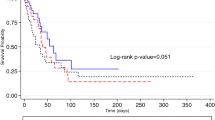Abstract
Healthcare-associated pneumonia (HCAP) is a new concept of pneumonia, which was proposed in the ATS/IDSA guidelines. The guidelines explain that HCAP patients should be treated with broad-spectrum antimicrobial drugs directed at multidrug-resistant pathogens. However, in Japan, there are many elderly people who received in-home care service. These patients seemed to be consistent with the concept of HCAP, but they did not meet the definition of HCAP. Therefore, the Japanese Respiratory Society modified the definition of HCAP according to the medical environmental in Japan. We retrospectively observed HCAP patients and nursing home and healthcare-associated pneumonia (NHCAP) patients who were hospitalized during 24 months at the Japanese Red Cross Nagasaki Genbaku Hospital (Nagasaki, Japan). Patient background, disease severity, identified pathogens, initial antibiotic regimens, and outcomes were compared. A total of 108 patients (77 HCAP and 31 NHCAP except HCAP patients) were evaluated. Of NHCAP except HCAP patients, 27 (87.1 %) were above 3 in the ECOG PS score. There were almost no significant differences between the two groups in characteristics, pneumonia severity, identified bacteria, initial antibiotic regimens, and response rate of initial antibiotic therapy. Although the in-hospital mortality of HCAP patients and NHCAP except HCAP patients was 9.1 % and 19.4 %, respectively, this difference did not reach statistical significance (P > 0.05). Our study suggested that, in the criteria of HCAP, some Japanese patients, who were consistent with the concept of HCAP, were classified as community-acquired pneumonia (CAP). Therefore, there is a need to change the definition of HCAP according to the medical environment in Japan.
Similar content being viewed by others
References
American Thoracic Society/Infectious Disease Society of America. Guidelines for the management of adults with hospital-acquired, ventilator-associated, and healthcare-associated pneumonia. Am J Respir Crit Care Med. 2005;171:388–441.
Kollef MH, Shorr A, Tabak YP, Gupta V, Liu LZ, Johannes RS. Epidemiology and outcomes of health-care-associated pneumonia: results from a large US database of culture-positive pneumonia. Chest. 2005;128:3854–62.
Micek ST, Kollef KE, Reichley RM, Roubinian N, Kollef MH. Healthcare-associated pneumonia and community-acquired: a single-center experience. Antimicrob Agents Chemother. 2007;51:3568–73.
Brito V, Niederman MS. Healthcare-associated pneumonia is a heterogeneous disease, and all patients do not need the same broad-spectrum antibiotic therapy as complex nosocomial pneumonia. Curr Opin Infect Dis. 2009;22:316–25.
Ewig S, Welte T, Chastre J, Torres A. Rethinking the concept of community-acquired and health-care-associated pneumonia. Lancet Infect Dis. 2010;10:279–87.
Population Division of the Department of Economic and Social Affairs of the United Nations Secretariat. World population prospects: the 2010 revision. New York: United Nations; 2011.
The committee for the Japanese Respiratory Society in the management of nursing and healthcare-associated pneumonia. Guidelines for the management of nursing and healthcare-associated pneumonia. Tokyo: The Japanese Respiratory Society; 2011.
Oken MM, Creech RH, Tormey DC, Horton J, Davis TE, McFadden ET, et al. Toxicity and response criteria of the Eastern Cooperative Oncology Group. Am J Clin Oncol. 1982;5:649–55.
Shindo Y, Sato S, Maruyama E, Ohashi T, Ogawa M, Imaizumi K, et al. Comparison of severity scoring systems A-DROP and CURB-65 for community-acquired pneumonia. Respirology. 2008;13:731–5.
Shindo Y, Sato S, Maruyama E, Ohashi T, Hashimoto N, Imaizumi K, et al. Health-care-associated pneumonia among hospitalized patients in a Japanese community hospital. Chest. 2009;135:633–40.
Seki M, Kosai K, Yanagihara K, Higashiyama Y, Kurihara S, Izumikawa K, et al. Disease severity in patients with simultaneous influenza and bacterial pneumonia. Intern Med. 2007;46:953–8.
Seki M, Watanabe A, Mikasa K, Kadota J, Kohno S. Revision of the severity rating and classification of hospital-acquired pneumonia in the Japanese Respiratory Society guidelines. Respirology. 2008;13:880–5.
Seki M, Hashiguchi K, Tanaka A, Kosai K, Kakugawa T, Awaya Y, et al. Characteristics and disease severity of healthcare-associated pneumonia among patients in a hospital in Kitakyushu, Japan. J Infect Chemother. 2011;17:363–9.
Mandell LA, Wunderink RG, Anzueto A, Bartlett JG, Cambell GD, Dean NC, et al. Infectious Diseases Society of America/American Thoracic Society consensus guidelines on the management of community-acquired pneumonia in adults. Clin Infect Dis. 2007;44:S27–72.
Fine MJ, Auble TE, Yealy DM, Hanusa BH, Weissfeld LA, Singer DE, et al. A prediction rule to identify low-risk patients with community-acquired pneumonia. N Engl J Med. 1997;336:243–50.
Lim WS, van der Eerden MM, Laing R, Boersma WG, Karalus N, Town GI, et al. Defining community acquired pneumonia severity on presentation to hospital: an international derivation and validation study. Thorax. 2003;58:377–82.
Japan Ministry of Health, Labour and Welfare. Annual Health, Labour, and Welfare Report 2009–2010. http://www.mhlw.go.jp/english/wp/wp-hw4/dl/health_and_welfare_services_for_the_elderly/2011071906.pdf. Accessed 2 July 2012.
Sugisaki M, Enomoto T, Shibuya Y, Matsumoto A, Saitoh H, Shingu A, et al. Clinical characteristics of healthcare-associated pneumonia in a public hospital in a metropolitan area of Japan. J Infect Chemother. 2011 (Epub ahead of print).
Yamagishi Y, Mikamo H. A retrospective study of health care-associated pneumonia patients at Aichi Medical University Hospital. J Infect Chemother. 2011;17:756–63.
Watanabe M, Kato K, Takeda K, Konishi T, Kurai J, Tatsukawa T, et al. Difference of health-care associated pneumonia between large hospitals and small hospitals in Japan. J Med Invest. 2011;58:67–74.
Author information
Authors and Affiliations
Corresponding author
About this article
Cite this article
Kaku, N., Yanagihara, K., Morinaga, Y. et al. The definition of healthcare-associated pneumonia (HCAP) is insufficient for the medical environment in Japan: a comparison of HCAP and nursing and healthcare-associated pneumonia (NHCAP). J Infect Chemother 19, 70–76 (2013). https://doi.org/10.1007/s10156-012-0454-z
Received:
Accepted:
Published:
Issue Date:
DOI: https://doi.org/10.1007/s10156-012-0454-z




